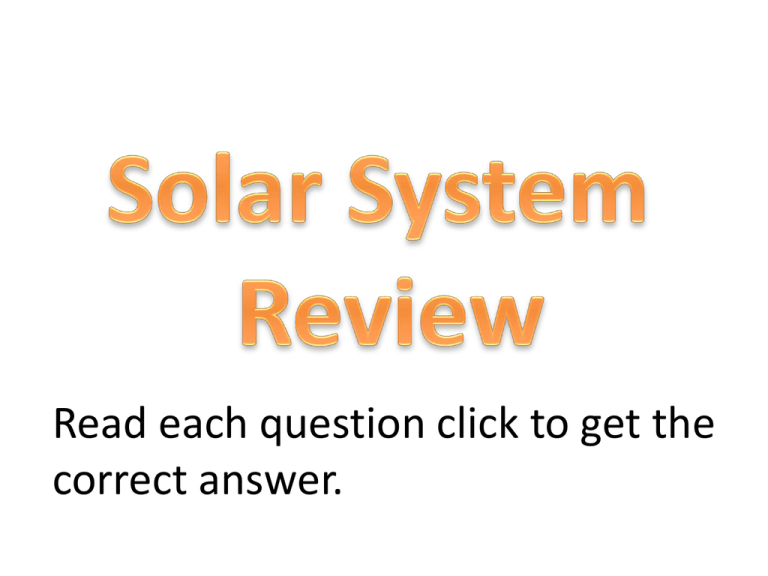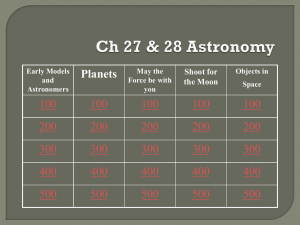Solar System Review
advertisement

Read each question click to get the correct answer. To spin around is to a. rotate. b. revolve. c. orbit. d. gravitate. Chunks of rock or metal that orbit the Sun are referred to as a. daystars. b. comets. c. meteorites. d. asteroids. Chunks of ice and other material that move in long, narrow orbits are a. asteroids. b. daystars. c. meteorites. d. comets. To move around an object is to a. rotate. b. revolve. c. gyrate. d. gravitate. The path a revolving object moves along is called its a. axis. b. destiny. c. orbit. d. projection. The cycle of day and night is caused by a. Earth’s orbit. b. the Sun’s rotation. c. Earth’s rotation. d. the movement of the Moon. Earth’s trip around the Sun takes a. one day. b. one year. c. one month. d. 24 hours. What causes Earth’s seasons? a. Earth’s tilted axis as it revolves around the Sun b. the Sun’s position in the sky c. Earth moving closer and then farther away from the Sun d. the Sun’s motion What is the name of the phase of the Moon when it is between the Sun and Earth? a. Full Moon b. First Quarter Moon c. New Moon d. Gibbous Moon The Sun is actually a hot sphere of gases called a(n) a. hydrogen. b. atmosphere. c. star. d. planet. What is a gibbous Moon? a. A full Moon b. A crescent Moon c. A “nearly-full” Moon d. A moon of Jupiter or Saturn As Earth moves around the Sun, it spins, or a. revolves. b. orbits. c. ellipses. d. rotates. A small chunk of rock or metal that orbits the Sun is a(n) a. comet. b. meteor. c. debris field. d. asteroid. Earth travels in a set path around the Sun, called its a. eclipse. b. phases. c. axis. d. orbit. The Sun, nine planets, their moons, and other smaller objects make up the a. galaxy. b. universe. c. solar system. d. Milky Way. A fragment of rock, ice, or metal that has broken off colliding comets or asteroids and burns up in Earth’s atmosphere is known as a(n) a. asteroid. b. meteor. c. satellite. d. minor planets. Earth’s path around the Sun is shaped like a(n) a. ellipse. b. spiral. c. circle. d. projection. Fragments of rock, ice, or metal that glow as they collide with Earth’s atmosphere are a. comets. b. boulders. c. meteors. d. rings. To move around another object on a circular path is to a. navigate. b. revolve. c. rotate. d. radiate. Earth is a satellite of the Sun, or a(n) a. planet. b. asteroid. c. constellation. d. globe. What characteristics do the inner planets share? a. They are the closest planets to the Sun. b. They are warmer and smaller than the other planets. c. They are made of solid, rock-like materials. d. All of the above Chunks of ice with bits of rock and dust, sometimes called “dirty snowballs,” are a. asteroid belts. b. comets. c. meteorites. d. auroras. A pattern or picture outlined by stars is called a(n) a. celestial sphere. b. star show. c. constellation. d. meteor shower When small meteoroids enter Earth’s atmosphere they most often a. hit land. b. burn up. c. hit the ocean. d. get bigger. Chunks of rock or metal orbiting the Sun that may be underdeveloped parts of planets or pieces of planets that have broken off are called a. stars. b. asteroids. c. comets. d. meteorites. While Earth is spinning on its axis, it also moves in a circular path around the Sun, or a. rotates. b. orbits. c. circles. d. revolves.











